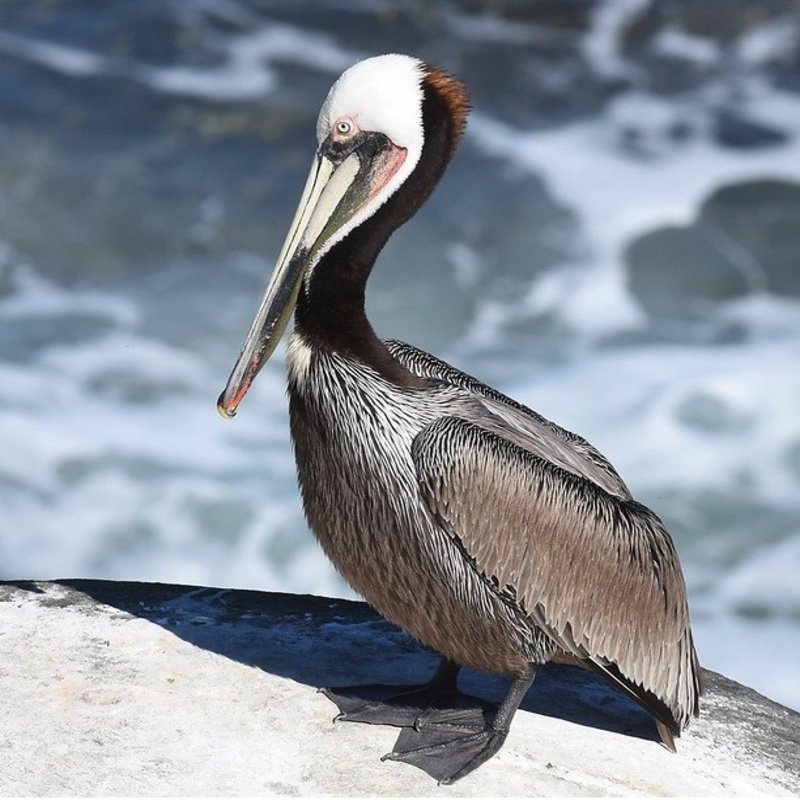The brown pelican, Pelecanus occidentalis is one of three American species that dive for food. New Jersey to the Amazon River mouth, BC to northern Chile, including the Galapagos Islands. The nominated subspecies have a golden-white head in breeding plumage. A dark maroon–brown nape unusually, the gular pouch has pale yellowish spots and white lines.
Quick Overview: Pelecanus Occidentalis – Brown Pelican
Body size: Around 48-50 in (122-127 cm) and weight of 3718 g (131.2 oz)
Main colors: White, Gray-brown, Black, Silver, Gray, Yellow
Range: Coastland of United States
Migratory Bird: Yes
Best time of the year to see in the U.S.: All Year (January – December)
Conservation Status: Least Concern
Brown Pelican Description
The first year’s underside is white, and molt cycles are rapid. These birds molt six times before reaching adulthood when they undergo dramatic changes in plumage. A grayish-brown abdomen and a black and silver striped underside alter the upper portions from gray to gray-brown. They molt three times as adults. The head and neck turn light yellow after breeding. Just before breeding, the head becomes yellow, but the neck darkens. Nesting birds have a white head, brown neck, and black feathers. Females molt first, while males do not.

Size
These birds have a length of 48-50 in (122-127 cm) and a weight of 3718 g (131.2 oz). Their wings could range from 78-84 in (198-213 cm).
Feeding
Brown pelicans are predators that eat fish and invertebrates. Only these pelicans dive for food. Their keen vision allows them to dive from up to 20 meters in the air. Although they have a poor underwater vision, they may be seen floating and eating by surface-seizing. The lower jaw is divided in two and emerges from the water, producing a scoop with the gular pouch. During the non-breeding season from late fall to early winter, brown pelicans may go up to 175 kilometers from the mainland and 75 km from an island foraging. They are rarely spotted feeding in freshwater lakes or streams but have been recorded diving up to 20 miles offshore.
Habitat
Although diurnal, they have been seen feeding at night during full moons. A pelican was tracked for 68.8 hours in 1986. The bird was active 32% of the time and inactive 68%. It was never active at night, seldom active at dusk, and most active during the day. Land sleeping Brown Pelicans have a flat head, a rounded beak, and a stooped posture. They generally stretch one wing, seldom both, when sunbathing. They bathe by lowering their heads and spreading their wings over the water. Brown pelicans utilize their beak to apply uropygial gland oil onto their feathers after bathing.
Behavior
Pelicans seldom live more than 20 miles (32 km) from the seashore. During the non-breeding season, they inhabit warm coastal or marine estuaries. They demand dry, undisturbed places. They roost offshore at night and loaf during the day. Sites for lounging and roosting include offshore rocks and islets, sandbars, jetties, and breakwaters. They breed on tiny predator-free islands.
Pelecanus occidentalis Scientific Classification
- Kingdom: Animalia
- Phylum: Chordata
- Subphylum: Chelicerata
- Class: Aves
- Order: Pelecaniformes
- Family: Pelecanidae
- Genus: Pelecanus
- Species: Pelecanus occidentalis
Best time of the year to see
In the United States, the best time of year to see these birds is all year round, regardless of the season. This refers to any month of the year between January and December.
Distribution of the Brown pelican in the USA
Brown pelicans inhabit warm, shallow seas in the Pacific and Atlantic oceans. Although primarily coastal, brown pelicans have been observed inland during the post-breeding season. Off the coast, these birds have been seen at Lake Okeechobee, Florida, and Salton Sea, California. This species breeds in 10 coastal states in the United States: Maryland, Maine, New Hampshire, Delaware, Virginia, Massachusetts, Connecticut, New Jersey, North Carolina, South Carolina.

